Statistical data serves as a cornerstone for bolstering the credibility of your research, lending factual support to your arguments across various academic endeavors such as class assignments, research papers, and theses. However, sourcing statistical data can pose a challenge due to its dispersed nature across a myriad of platforms including scholarly journals, magazines, newspapers, reports, websites, books, statistical databases, and more.
It’s crucial to note that accessing the most current statistics might entail data that is at least a year old. This delay stems from organizations adhering to data collection cycles, the time required for data analysis and reporting, and the schedule for public release.
This guide provides a roadmap for effectively locating and evaluating statistical data. It’s essential to acknowledge that the precise statistics you seek may not always be readily available; some data might have never been collected, or it could be held privately. Hence, maintaining flexibility and considering alternative measures are pivotal strategies in supporting your research endeavors.
Statista
The Statista database offers a wealth of current statistics sourced from both private and government outlets, covering diverse topics such as technology, health, public opinion, and market research. To delve into detailed information about the sources of statistics in Statista, click here.
Accessing Statista is straightforward: simply hover over Research Resources on the Library homepage and select A-Z Databases.
Upon reaching the Statista homepage, input keywords relevant to your research topic to access a trove of Statistics and Studies & Reports. Note that NU’s subscription excludes Market Outlooks, rendering content under the “Expert Tools” menu inaccessible.
Here’s an overview of the content types available:
- Statistics: Access over 1,000,000 statistics sourced from four databases in German, English, French, and Spanish.
- Forecasts & Surveys: Explore 5-year forecasts on trending topics and exclusive surveys among consumers and experts.
- Infographics: Engage with visually appealing visualizations of current events for enhanced understanding.
- Topics: Discover over 80,000 topics serving as an ideal starting point for your research.
- Studies & Reports: Dive into a database housing over 32,000 external studies to deepen your insights.
- Companies: Access information on over 5,000 companies via the company database.
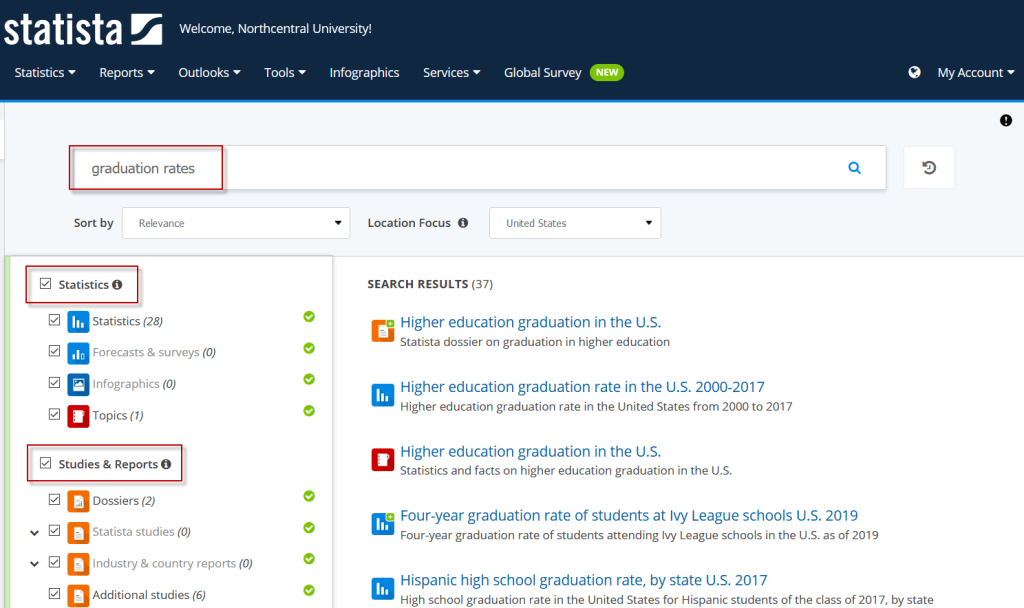
The search results screen defaults to displaying the most relevant content first, utilizing a formula specifically developed for this purpose. You can modify the sorting feature to Date of Publication or Popularity by using the “Sort by” drop-down menu beneath the search box.

Content from the United States is prioritized, meaning it ranks higher in your search results. You can adjust this prioritization to focus on another country using the “Location Focus” menu.

Additional filter options, including Regions, Countries & Territories, Industry, Publication date, and Archive, can be found below the content type filters on the left-hand menu. The Archive feature allows you to access results from archived news entries, which may no longer be current but are still valuable.
The “Search accuracy” feature enables you to refine your search using search specification parameters:
- Normal: Searches for entered terms using an AND connective.
- Wide: Searches for entered terms using an OR connective.
- High: Displays only the most relevant results of a search for entered terms using an AND connective.

To explore all available search commands in Statista, including Boolean operators, phrase searching, and wildcards, click here.
Browse statista
In addition to searching for specific statistics, you can also browse Statista to discover valuable insights. Simply navigate to the drop-down menu at the top of the screen. From there, you have several browsing options:
- Browse by Industry: Gain industry-specific insights by selecting this option. Explore statistics tailored to various sectors, from technology and healthcare to finance and beyond.
- Browse by Recent Statistics: Stay updated with the latest trends and data by browsing through recent statistics. This option allows you to access newly published information across a wide range of topics.
- Browse by Popular Statistics: Discover what’s trending and garner insights into popular topics by browsing through Statista’s collection of popular statistics. This feature enables you to explore data that is generating significant interest and attention.
- Browse by Topic: Explore statistics based on specific topics of interest. Whether you’re researching healthcare, consumer trends, or global economics, you can find relevant data organized by topic for easy access.
Please note that NU’s subscription does not include access to the Market Outlooks section, so content under the Outlooks menu will be unavailable. However, you can still explore a wealth of valuable statistics and insights through the other browsing options available on Statista.

View & Download
View and Download Statistics on Statista:
- Viewing Full Records: From the search results screen, simply click on the statistic you are interested in to access the full record. This will provide you with detailed information and visualization of the data.
- Downloading Options: Statista offers several download formats to suit your needs:
- PNG: Download the statistic as a .png image, ideal for embedding into documents. The visual representation remains intact, but neither the data nor the visualization can be changed afterwards.
- PDF: Save the statistic as a PDF file, perfect for sharing via email. Like PNG, the data and visualization cannot be altered after downloading.
- XLS: Obtain the raw data of the statistic in an Excel file format. This allows you to further process and visualize the data according to your requirements. The second sheet provides comprehensive information about the source, survey, and release.
- PPT: Download the statistic as a PowerPoint slide, suitable for integration into presentations. The download includes multiple slides with different visualizations, providing flexibility for your presentation needs.

- Customization Options: Charts can be customized under settings. Click on the Gear icon to adjust the chart type and data labels. For instance, you can remove individual labels if the chart appears overcrowded with data labels.
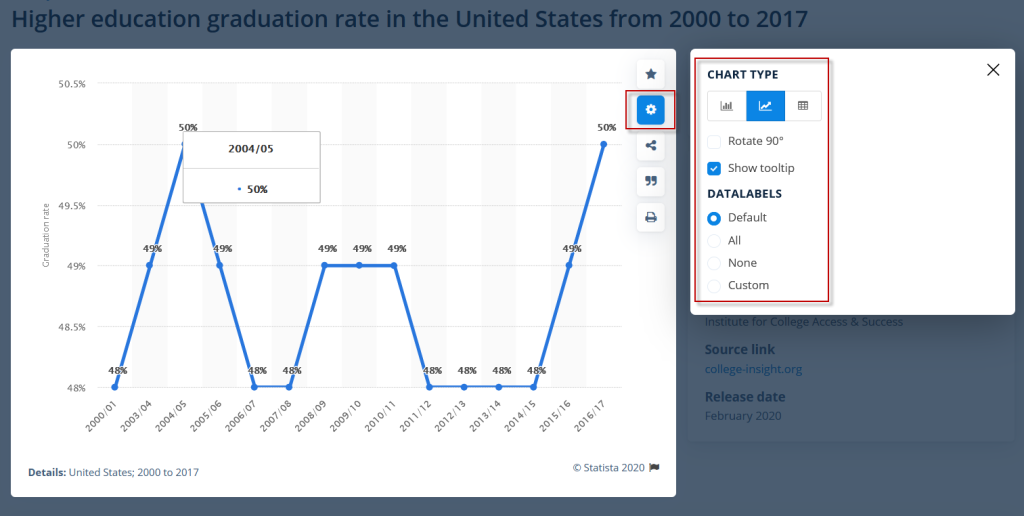
2. Sharing and Embedding: Statista allows you to share charts on social media or embed them in web pages. Click on the Share icon to select from the available sharing options or to view the embed code.
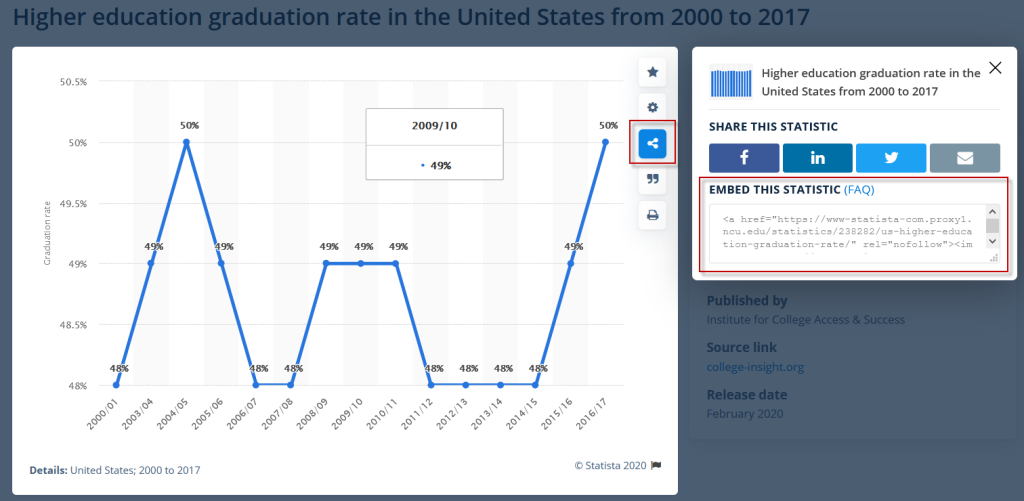
3. Related Content: At the bottom of the screen, you’ll find related statistics, topics, and studies. This feature enables you to explore additional relevant information related to your research interests.

Cite statista
Statista offers a convenient citation tool located on the right-hand side of the screen, below the download options. To cite a statistic, simply follow these steps:
- Select APA from the citation drop-down menu.
- The citation will be generated automatically based on the APA format guidelines.
However, it’s essential to verify the accuracy of the citation format with the latest edition of the Publication Manual of the American Psychological Association (APA), particularly the Seventh Edition.
It’s important to remember that while the citation tool provides guidance, it’s always recommended to double-check the citation format against authoritative sources like the APA manual.
For comprehensive assistance with academic writing, referencing, and APA style, utilize the resources available on the Academic Success Center website. The Academic Success Center offers coaching services and provides access to a wealth of resources, including:
- Writing guides
- Statistical assistance
- Editing resources
- APA Style guidelines
Additionally, the Academic Success Center provides access to Academic Writer, which offers over 150 sample references and nearly 10 sample papers. It encompasses all the references and content from the Publication Manual, making it a valuable tool for academic writing and citation management.
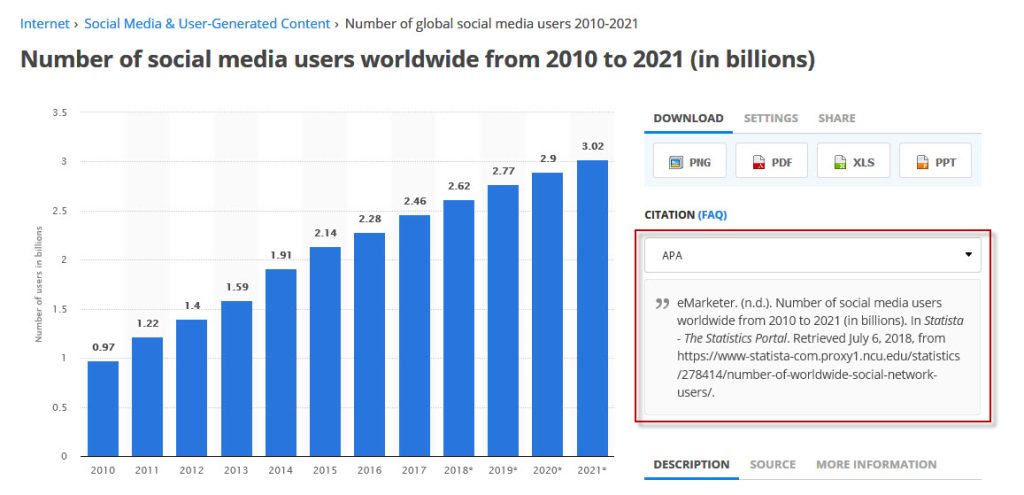
Kindly be advised that the provided information is intended solely as guidance. For comprehensive assistance, we recommend utilizing the Academic Success Center website. There, you can access coaching services and find resources on writing, statistics, editing, and APA Style guidelines.
Additional Resources
Journal Articles
Journal articles are valuable sources for obtaining statistics related to your research topic. The Library’s NavigatorSearch is an excellent starting point for accessing such articles, as it allows you to search across multiple databases simultaneously. To begin your search, navigate to the Library’s homepage and locate the NavigatorSearch box in the middle of the page. Click on the “Advanced Search” link to access more search options.
When conducting your search, consider including keywords such as “statistics,” “ratio,” “proportion,” and “rate” in your search string. Additionally, you may want to include terms like “prevalence,” “percentage,” “numbers,” “increase,” “decrease,” “data,” “trends,” “polling,” “figures,” and “tables” to broaden your search and uncover relevant articles. These keywords can help you locate articles containing statistical information pertinent to your research inquiry.

Search engines
Searching in Google or another internet search engine is a convenient way to find statistics relevant to your research topic. Reliable sources of statistics accessible through these search engines may include government and technical reports, scholarly journal articles, conference papers, white papers, and materials from professional organizations.
However, when retrieving statistics from the internet, it’s crucial to assess the reliability and appropriateness of the source for scholarly research. Refer to the earlier section on Evaluating Statistics for specific criteria to consider when evaluating the credibility of statistical sources. Additionally, the Website Evaluation page offers further guidance on factors to consider before incorporating online sources into your research.
To optimize your search results in Google, consider including the keyword “statistics” in your search query, along with other relevant terms such as “ratio,” “proportion,” “rate,” “percentage,” “prevalence,” “numbers,” “increase,” “decrease,” “data,” “trends,” “polling,” “figures,” and “tables.” Adding the publication year can also help you locate more recent statistics on your topic.
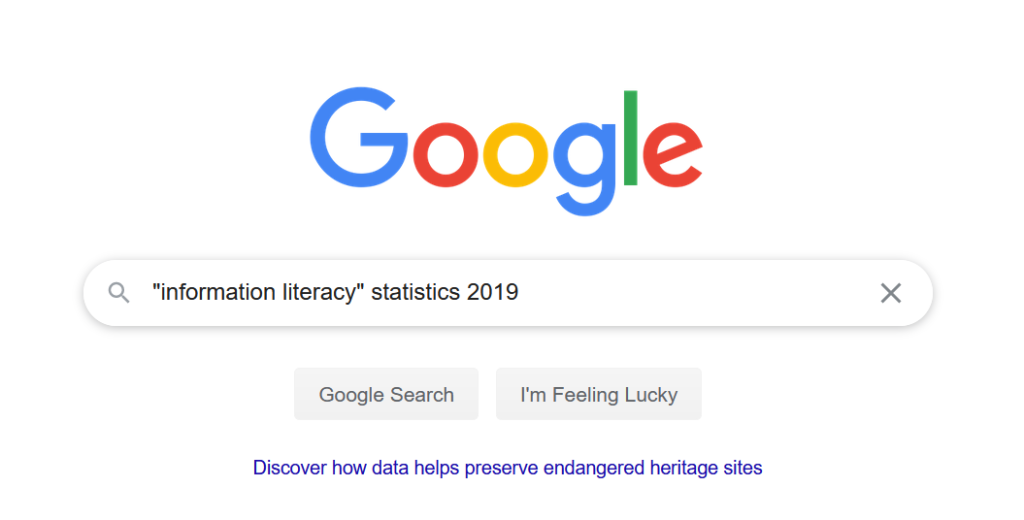
U.S Statistics
- Association of Religion Data Archives: Offers access to surveys, polls, and other data related to religion, aiming to democratize data access.
- Bureau of Economic Analysis: Provides accurate and objective data on the nation’s economy.
- Bureau of Justice Statistics: Offers information on crime, criminal offenders, victims of crime, and justice system operations at all government levels.
- Bureau of Labor Statistics: Principal fact-finding agency for labor economics and statistics, offering independent national statistical data.
- Centers for Disease Control and Prevention (CDC) – FastStats: Provides quick access to statistics on public health topics, alphabetically organized.
- ChildStats.gov: Offers statistics on children and families across various domains, including health, education, and economic circumstances.
- Data.gov: Houses the U.S. Government’s open data, providing resources for research, application development, and data visualization.
- Department of Homeland Security – Data: Provides statistical information on citizenship, immigration, FEMA, and related topics.
- FRED (Federal Reserve Economic Data): Allows users to download, graph, and track a vast array of US and international time series data.
- Integrated Postsecondary Education Data System (IPEDS): Offers statistics related to postsecondary education, including admissions, enrollment, and demographics.
- National Center for Education Statistics (NCES): Collects and reports comprehensive statistics on the condition of American education.
- U.S. Census Bureau: Provides data on population, housing, economy, and demographics through initiatives like Easy Stats and the American Community Survey.
- U.S. Energy Information Administration: Offers information and data on energy production, stocks, demand, and prices.
- U.S. Statistical Abstract: A comprehensive summary of statistics on the social, political, and economic organization of the United States.
- USDA Economic Research Service: Conducts economic research on agriculture, food, the environment, and rural America to inform decision-making.
- USDA National Agricultural Statistics Service: Conducts surveys and prepares reports on various aspects of U.S. agriculture, including production, prices, and demographics.
These sources cover a wide range of topics, making them valuable for research, policy-making, and decision-making processes.
International Statistics
- AidData: A research lab focusing on sustainable development investments, providing policymakers with evidence-based data.
- CIA World Factbook: Offers comprehensive information on world entities, including demographics, economics, and government.
- DataBank: Allows users to analyze and visualize time series data on various topics, customize queries, and share findings.
- EasyData: A collection of South African macroeconomic, industry, trade, and regional indicators.
- Eurostat: The statistical office of the European Union, providing high-quality statistics for Europe.
- FAOSTAT: Offers free access to food and agriculture data for over 245 countries and territories.
- Food and Agricultural Organization of the United Nations (FAO): Collects and disseminates food and agriculture statistics for decision-making.
- Gallup.com: Provides global statistics on employee well-being, engagement, and trust in leadership.
- Global Health Observatory: World Health Organization’s portal for health-related statistics.
- Google Public Data: Turns large datasets into easily digestible visualizations like graphs and maps.
- ILOSTAT: Compiles labor statistics for international comparison through various data tools.
- IMF Data: Includes databases on international financial, trade, government finance, and balance of payments statistics.
- International Data Base: Provides demographic indicators and population pyramids for countries with populations of 5,000 or more.
- International Energy Agency: Collects and analyzes energy data to ensure energy security and track clean energy transitions.
- OECD Statistics: Online platform for accessing the Organisation for Economic Co-operation and Development’s statistical databases.
- Trade Map: Offers indicators on export performance, international demand, and competitive markets, along with a directory of importing and exporting companies.
- UN Comtrade Database: Provides detailed global trade data, serving as a repository of official international trade statistics.
- UNdata: Aggregates statistical resources from the United Nations and other international agencies on various themes.
- World Bank Open Data: Provides free access to global development data, including education statistics.
- World Statistics: Offers easy access to data from international organizations like the World Bank, United Nations, and Eurostat.
These resources cover a wide range of topics and regions, enabling researchers, policymakers, and organizations to gain insights into global trends and phenomena.
Specific Countries
Accessing statistical information specific to individual countries is essential for understanding their social, economic, and demographic landscapes. Here are some valuable resources:
- Statistical Agencies of Other Countries: This directory, managed by the U.S. Bureau of Labor Statistics, provides access to statistical agencies in various countries. These agencies typically collect and publish official statistics on employment, wages, inflation, and other economic indicators.
- National Statistical Offices Websites: Maintained by the United Nations Statistics Division, this directory offers links to the official websites of national statistical offices around the world. These websites are valuable sources of comprehensive statistical data covering various aspects of each country, such as population, education, health, and labor.
- United Nations Statistics Division: Country Profiles: This central repository provides detailed country profiles of statistical systems worldwide. Each profile includes information on the country’s statistical history, legal framework, and current statistical programs. These profiles offer valuable insights into the organization and operation of national statistical systems, facilitating comparative analysis and research across different countries.
In addition to these resources, researchers and policymakers can also explore specific government ministries, research institutes, and international organizations dedicated to collecting and disseminating statistical data for individual countries. By accessing a diverse range of sources, users can gain a comprehensive understanding of each country’s socio-economic dynamics and make informed decisions based on reliable statistical evidence.
